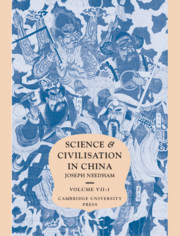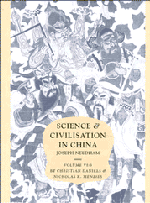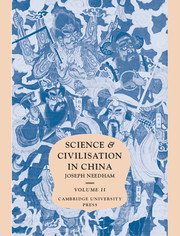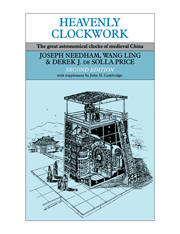Science and Civilisation in China
Science and Civilisation in China, Volume 7 Part 1 is the first book in the final volume of this unique resource. The Chinese culture is the only culture in the world that has developed systematic logical definitions and reflections on its own and on the basis of a non-Indo-European language. Christoph Harbsmeier discusses the basic features of the classical Chinese language that made it a suitable medium for science in ancient China, discussing in detail a wide range of abstract concepts that are crucial for the development of scientific discourse. There is special emphasis on the conceptual history of logical terminology in ancient China, and on traditional Chinese views on their own language. Finally the book provides an overview of the development of logical reflection in ancient China, first in terms of the forms of arguments that were deployed in ancient Chinese texts, and then in terms of ancient Chinese theoretical concerns with logical matters.
- Part of the authoritative and unique Science and Civilisation in China series
- Detailed analysis of the role the ancient Chinese language played in forming the foundations of Chinese science
- Insights into the parallels with ancient Greek and Buddhist logic
Reviews & endorsements
"Joseph Needham's masterpiece, chronicling the scientific and technical achievements of the world's oldest continuous civilization, has by now illuminated almost every aspect of the intellectual history of East Asia." David Wright, Isis
"This latest volume in the monumental series Science and Civilisation in China is singular. Unlike its companion volumes, it treats not the history of science but the comparitive history of the foundations of science in language and logic." China Review International
"[An] astonishing and enduring study...[Needham brings] depth of emotion and technical finesse to his task."
Jonathan Spence, New York Review of Books
"Perhaps the greatest single act of historical synthesis and intercultural communication ever attempted by one man."
Laurence Picken, Cambridge University
Product details
March 1998Hardback
9780521571432
504 pages
254 × 195 × 36 mm
1.36kg
Available
Table of Contents
- Foreword Joseph Needham
- Preface
- SECTION 49: LANGUAGE AND LOGIC IN TRADITIONAL CHINA
- A: METHOD:
- 1. Methodological remarks
- 2. The history of the study of classical Chinese language and logic in the West
- B: TYPOLOGY:
- 1. The place of Chinese among East Asian languages
- 2. Spoken Chinese and the semiotics of Chinese characters
- 3. Traditional Chinese comments on language
- 4. The art of definition
- 5. Dictionaries in traditional China
- 6. The art of grammar in traditional China
- 7. The art of literacy in traditional China
- C: LOGIC:
- 1. Negation and the law of double negation in classical Chinese
- 2. Logical sentence connectives
- 3. Logical quantifiers
- 4. Lexical and grammatical categories
- 5. Logical and grammatical explicitness
- 6. Logical and grammatical complexity in classical Chinese
- D: SENTENCES:
- 1. Punctuation and the concept of a sentence
- 2. The concept of meaning
- 3. The concept of truth
- 4. The concept of necessity
- 5. The concept of contradiction
- 6. The concept of a class
- 7. Abstraction and the concept of a property
- 8. The concept of subsumption
- 9. The concepts of knowledge and belief
- E: RATIONALITY:
- 1. Argumentation and rationality in early China
- 2. Some forms of argument in ancient China
- F: HUI SHIH:
- 1. Teng Hsi and Hui Shih
- 2. Kungsun Lung and the White Horse dialogue
- Appendix to 2. The mass noun hypothesis and the part-whole analysis of the White Horse dialogue
- 3. Hsun Tzu's logic
- 4. Later Mohist logic
- 5. Chinese reactions to ancient Chinese disputation and logic
- 6. Logical thought in the 3rd century
- G: BUDDHIST LOGIC:
- 1. History of Buddhist logic
- 2. The system of Buddhist logic
- 3. The argument for consciousness only
- 4. The translation of logic from Sanskrit to Chinese
- 5. Contrasts between Yin Ming and Aristotelian logic
- CONCLUDING REFLECTIONS
- Bibliography
- Index.









